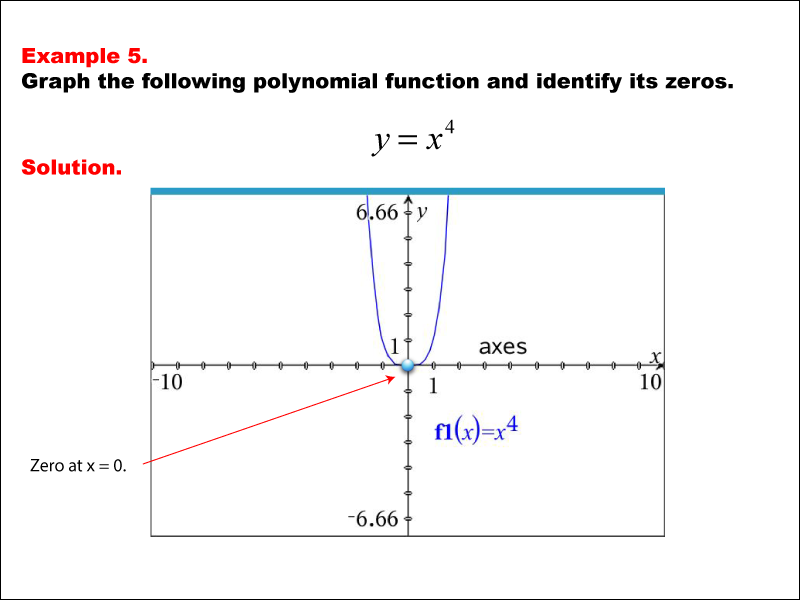
Display Title
Math Example--Polynomial Concepts--Graphs of Polynomial Functions--Example 05
Display Title
Math Example--Polynomial Concepts--Graphs of Polynomial Functions--Example 05

Topic
Polynomials
Description
A graph of the polynomial function y=x4 is displayed. The graph shows a symmetric parabola-like curve with a minimum point at x=0. The zero of the function is marked at x=0. Example 5: 'Graph the following polynomial function and identify its zeros.' The function is y=x4, and the graph shows that the zero occurs at x=0.
Polynomial functions, particularly cubic and quartic polynomials, exhibit different behaviors based on their structure. By graphing these functions, students can see how coefficients and terms affect the shape and zeros of the graph. These examples help students connect the algebraic expression of a polynomial to its graphical representation, reinforcing their understanding of concepts like zeros, symmetry, and end behavior.
Seeing multiple worked-out examples is essential for students to fully understand polynomial functions. Each example illustrates different characteristics—like where the graph crosses the x-axis and how the shape varies—helping students recognize patterns and anticipate behaviors in similar functions.
Teacher’s Script: Take a look at this polynomial function. Notice where the graph intersects the x-axis—that’s where the zeros are located. In this example, the polynomial shows a unique structure that determines its graph's shape. As you analyze this, think about how changes in each term affect the graph's behavior and position.
For a complete collection of math examples related to Graphs of Polynomial Functions click on this link: Math Examples: Graphs of Polynomial Functions Collection.
What Are Polynomials?
Polynomials Are Made Up of Monomials
A monomial is a single expression that is usually the product of a number and one or more variables raised to a positive exponent power. Read the following definition.
A monomial is an example of a polynomial.
Binomials Are Made Up of Two Monomials
If you combine two monomials, you have a binomial, so long as the two monomials cannot be further added or subtracted. Read the following definition.
Notice how each binomial is made up of two monomials. Here’s an example of two monomials that, when combined, result in a monomial, not a binomial.
Trinomials Are Made Up of Three Monomials
If you combine three monomials, you have a trinomial, so long as the monomials cannot be further added or subtracted. Read the following definition.
Notice how each binomial is made up of three monomials.
The Degree of a Polynomial
The term with the highest exponent determines the degree of the polynomial.
This is a polynomial of degree 1:
This is a polynomial of degree 2:
This is a polynomial of degree 3:
| Common Core Standards | CCSS.MATH.CONTENT.HSA.APR.B.3, CCSS.MATH.CONTENT.HSF.IF.C.7, CCSS.MATH.CONTENT.HSF.IF.C.7.C |
|---|---|
| Grade Range | 9 - 12 |
| Curriculum Nodes |
Algebra • Polynomials • Polynomial Functions and Equations |
| Copyright Year | 2020 |
| Keywords | polynomial functions |